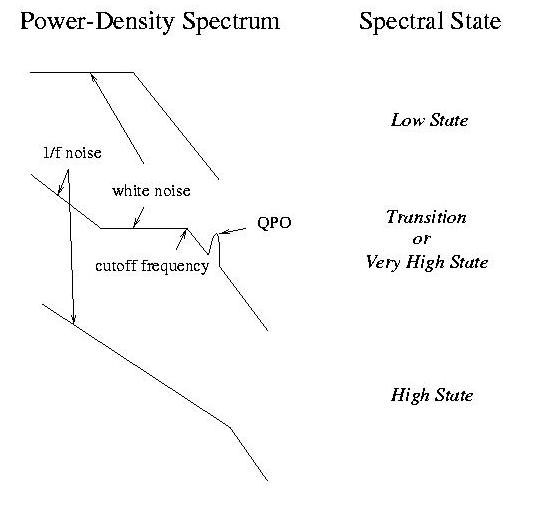 Fig 1: Typical
PDS of black hole candidates in the different states
Fig 1: Typical
PDS of black hole candidates in the different states
Together with X-ray spectroscopy, the study of rapid (periodic, quasi-periodic or aperiodic) time variability is the main way to obtain information on the physical environment very close to the accreting source.
The main features of the X-ray binaries Fourier spectra
In analogy with the ``state'' classification of X-ray binary spectra, it is possible to trace the evolution of sources (and their state transitions) looking at particular features in their Power Density Spectra (PDS).
 Fig 1: Typical
PDS of black hole candidates in the different states
Fig 1: Typical
PDS of black hole candidates in the different states
The most common of these are broad-band noise (known in general as `white' noise, in which the power spectrum is constant over a certain frequency range, or `red' noise, for which P (f)~ f^(-p) and p~1) and Quasi-Periodic Oscillations (QPOs). The latter are (more or less) well defined peaks in the PDS, the centroid frequency of which is regarded as the preferred frequency of the oscillation. It has to be borne in mind that there is some freedom in the distinction between a QPO and broader local maxima in the PDS (sometimes called `peaked noise'), and this freedoms reflect itself in the different definitions that can be found in the literature.
Noise properties of rapidly time-varying X-ray binaries have been studied over a long time. Quite early, for example, in the study of the first black hole candidate, Cygnus X-1, in its Low/Hard state, it was pointed out its extreme variability over many time scales, ranging from milliseconds to tens of seconds, and since then the properties of the noise features of Cygnus X-1 has been studied in detail. The same kind of timing analysis has been applied to almost all known sources.
Large efforts have also been devoted to the observation, classification and theoretical explanation of quasi-periodic oscillations. They are common in all the power spectra of X-ray binaries and their phenomenology is extremely rich, QPOs frequencies ranging from tenths of Hertz to kilohertz. They have been observed in BHC and in neutron star systems.
QPOs correlation: possible tests of General Relativity ?
The most striking observational fact of the quasi-periodic oscillations phenomenology is the observed tight correlation, extending over many decades in frequencies, among kHz QPOs, f~ 10 Hz QPOs and broad-band noise features in both black hole candidates and neutron star X-ray binaries (and indeed the correlation is the same for both kind of sources). These observation are giving strength to the idea that a single physical mechanism, more probably related to nature of the accretion flow than of the source itself, is the responsible for QPOs generation.
Correlations among different frequency QPOs has been supposed to be indication of general relativistic phenomena like frame dragging (Lense-Thirring and also `peristar' precession) or diskeoseismic modes trapped in the inner regions of the accretion disc.
Hard X-rays time lags in black hole candidates
Another interesting (and somewhat puzzling) phenomenon is the hard X-ray time lag observed in many BHC in their Low/Hard state . As the hard X-ray spectral component is believed to originate from inverse Compton scattering of soft photons in a hot medium (corona), harder photons undergo more scattering events, and are thus lag the softer ones. But the observed time lags are very long (even of the order of seconds) and strongly frequency dependent, so not explainable by a Comptonization model, unless one postulates the existence of a density gradient in a corona extending over 1000 Schwarzschild radii (which is in itself a problem for the energetics of the system).
Current work
We are at present studying the rich and complicated phenomenology of
black holes QPOs and noise features. We have used, for example, the
observed drifting ~0.1 Hz QPO observed in the optical and X-ray light curves
of the X-ray transient XTE J1118+480, together with spectral energy density
information, to pose limits on the inner radius of the accretion disc in
this source. Furthermore, we are investigating the possibility to
constrain the nature of the coronal emission
using the noise characteristics of BHCs.